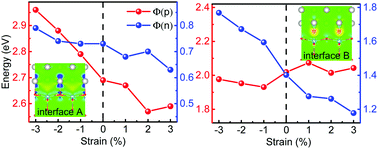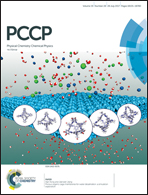Schottky barrier and band edge engineering via the interfacial structure and strain for the Pt/TiO2 heterostructure†
Abstract
Charge transfer across the Pt/TiO2 interface, which is mainly determined by the interface Schottky barrier height (SBH), is an important process in the (photo)catalytic and electronic applications of the Pt/TiO2 composite. Therefore, systematic investigation of the factors that affect the interface SBH is indispensable for understanding and optimizing its performance. In this work, a systematic study of the effects of the interfacial structure and strain on the SBH of the Pt/TiO2(001) interface has been carried out based on the first-principles calculations. The results of interface adhesion energy show that two different interfacial structures for the Pt/TiO2(001) heterointerface may exist experimentally, namely, O–Pt bonding and Ti–Pt bonding. Moreover, the interfacial structures result in not only different values for the SBH, but also different dependences of the SBH on strain. Detailed investigations show that these versatile modulations of the SBH with the structure and strain are mainly attributed to the strong dependence of the band edges of TiO2 and the interfacial potential alignments on the strain and structure, suggesting that these results are general and may be applicable to other metal/TiO2 heterostructures.



 Please wait while we load your content...
Please wait while we load your content...